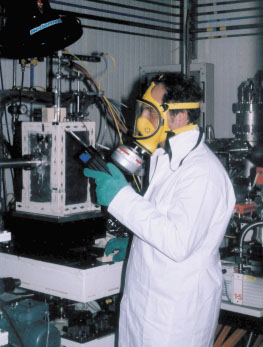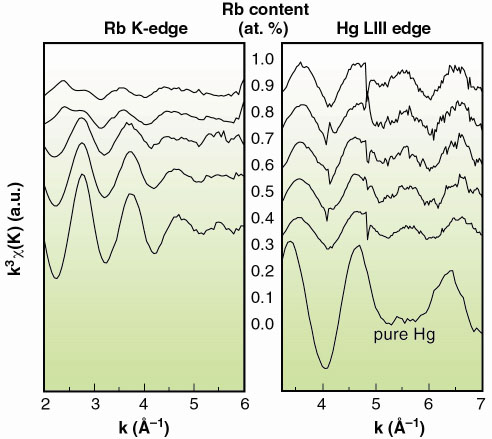- Home
- Users & Science
- Scientific Documentation
- ESRF Highlights
- ESRF Highlights 2001
- Materials
- The Structure of Liquid Hg-alkali Alloys
The Structure of Liquid Hg-alkali Alloys
Mercury, the liquid metal by excellence, has always fascinated scientists and even artists. Whereas the mercury fountain of Alexander Calder continuously cycles its content at the Miro museum of Barcelona, scientists try to enter the mysteries of this particular liquid. The advent of 3rd generation X-ray sources such as the ESRF has made it possible to overcome the technical impediments for solving one of the longstanding mysteries of mercury: that its conductivity decreases with the addition of alkali metals. This is even more surprising as we know that the addition of non-alkali simple metals to mercury decreases its anomalously high electrical resistivity down to the typical values of simple liquid metals. The work of P.D. Adams [1], N.F. Mott [2], and others, at the beginning of the seventies provided an understanding of the behaviour of mercury and its alloys with non alkali metals within the near free electron model framework. However, the behaviour of mercury-alkali amalgams remained unexplained. N.F. Mott concluded that something different due to a charge transfer, such as the solvation of Hg by alkali atoms, should take place. Many years have passed and still no one has been able to prove Mott's hypothesis. This is not surprising as mercury is an extremely good X-ray and neutron absorber and this has impeded the structural studies.
EXAFS spectroscopy excels in the structural studies of alloys because of its atomic selectivity. We have chosen to study Hg-Rb liquid amalgams, because the accessibility of Hg and Rb edges allowed probing of the local structure around both atoms. The toxicity of Hg, the spontaneous ignition of Rb in the atmosphere, in addition to the corrosive properties of the liquid alloy, imposed severe safety constraints as shown in Figure 111. In the particular case of Hg-Rb liquid alloys we can take advantage of additional selectivity (due to the strong contrast of photoelectron scattering amplitudes): not only are we able to distinguish the central atom selected, but also the nature of the neighbours contributing to the EXAFS signal. In fact, at both Rb K and Hg L edges, only Hg neighbours are resolved, providing respectively a direct signature of the Rb-Hg and Hg-Hg neighbour correlations (i.e. the low distance part of the partial radial distribution functions).
 |
Fig. 111: Scientist checking the sealing of the Hg-Rb cell at the BM29 beamline. |
Already, without the need of a detailed analysis, the main results are very clear. We observe in Figure 112 that at the Rb K-edge, the amplitude of the EXAFS signal increases with the Hg content. This is what would be expected in any ordinary alloy: if we progressively add Hg atoms, the number of Hg neighbours around Rb increases. The situation is dramatically different when we look at the EXAFS signal at the Hg edges: the distribution of Hg neighbours around Hg does not change. In addition this distribution is markedly different from the one of pure liquid mercury. The data analysis shows that this behaviour is closely related to what has been observed in crystalline Hg-alkali amalgams where mercury associates in units of 4-5 atoms encaging the alkali atoms. This is also observed in Zintl-type compounds forming clathrate-type structures very similar to the ones of the Hg-alkali crystalline amalgams. Mott's suspicion, even if not totally right, was a good starting point.
 |
Fig. 112: EXAFS oscillations as a function of Rb content. |
References
[1] P.D. Adams., Phys. Rev. Lett. 20, 537 (1968).
[2] N.F. Mott, Philos. Mag. 26, 505 (1972).
Principal Publication and Authors
A. San-Miguel (a), G. Ferlat (a), J.F. Jal (a), A. Mizuno(b), T. Itami(b) and M. Borowski(c), submitted to Phys. Rev. B.
(a) Département de Physique des Matériaux, CNRS, Université de Lyon (France)
(b) Department of Chemistry, Hokkaido University, Sapporo (Japan)
(c) ESRF



